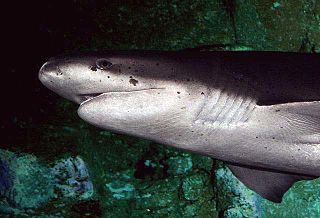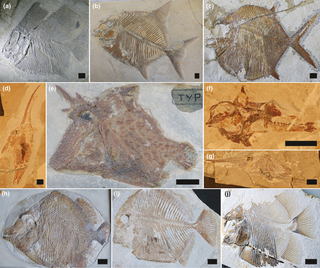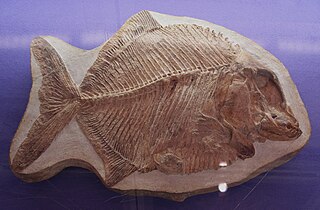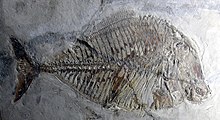
James Strom Thurmond Sr. was an American politician who represented South Carolina in the United States Senate from 1954 to 2003. Prior to his 48 years as a senator, he served as the 103rd governor of South Carolina from 1947 to 1951.

The Hexanchiformes are a primitive order of sharks, that numbering just seven extant species in two families. Fossil sharks that were apparently very similar to modern sevengill species are known from Jurassic specimens.

Semionotiformes is an order of ray-finned fish known from the Middle Triassic (Anisian) to the Late Cretaceous (Maastrichtian). Their closest living relatives are gars (Lepisosteidae), with both groups belonging to the clade Ginglymodi within the Holostei. The group includes both freshwater (Semionotidae) and marine adapted forms. Many members of the family Macrosemiidae, had elongated dorsal fins, often associated with an adjacent area of skin which was free of scales. These fins were likely undulated for use in precision swimming. The body morphology of macrosemiids suggests that they were slow swimmers that were capable of maneuvering around complex topography, such as reef environments.

Nathaniel Thurmond was an American basketball player who spent the majority of his 14-year career in the National Basketball Association (NBA) with the Golden State Warriors franchise. He played the center and power forward positions. Thurmond was a seven-time All-Star and the first player in NBA history to record an official quadruple-double. In 1965, he grabbed 42 rebounds in a game; only Wilt Chamberlain and Bill Russell recorded more rebounds in an NBA game. Thurmond was named a member of the Naismith Memorial Basketball Hall of Fame in 1985, one of the 50 Greatest Players in NBA History, and part of the NBA 75th Anniversary Team in 2021.

The Lamniformes are an order of sharks commonly known as mackerel sharks. It includes some of the most familiar species of sharks, such as the great white, as well as more unusual representatives, such as the goblin shark and megamouth shark.

The Lamnidae are the family of mackerel sharks known as white sharks. They are large, fast-swimming predatory fish found in oceans worldwide, though prefer environments with colder water. The name of the family is formed from the Greek word lamna, which means "fish of prey", and was derived from the Greek legendary creature, the Lamia.

David Ivor Young, Baron Young of Graffham, was a British Conservative politician, cabinet minister and businessman.

Pycnodus is an extinct genus of ray-finned fish from the Eocene period. It is wastebasket taxon, although many fossils from Jurassic or Cretaceous are assigned to this genus, only Eocene species, P. apodus is valid. As its name suggests, it is the type genus of Pycnodontiformes.

Myliobatis is a genus of eagle rays in the family Myliobatidae.

Carcharias is a genus of mackerel sharks belonging to the family Odontaspididae. Once bearing many prehistoric species, all have gone extinct with the exception of the critically endangered sand tiger shark.

Pycnodontiformes is an extinct order of primarily marine bony fish. The group first appeared during the Late Triassic and disappeared during the Eocene. The group has been found in rock formations in Africa, Asia, Europe, North and South America. They were small to middle-sized fish, generally with laterally-compressed deep bodies, some with almost circular outlines, adapted for manuverability in reef-like environments, though the group was morphologically diverse. Most, but not all members of the groups had jaws with round and flattened teeth, well adapted to crush food items (durophagy), such as echinoderms, crustaceans and molluscs. Some pyncodontiformes developed piranha like teeth used for eating flesh. Most species inhabited shallow marine reef environments, while a handful of species lived in freshwater or brackish conditions. While rare during the Triassic and Early-Middle Jurassic, Pycnodontiformes became abundant and diverse during the Late Jurassic, exhibiting a high but relatively static diversity during the Early Cretaceous. At the beginning of the Late Cretaceous they reached their apex of morphological and species diversity, after which they began to gradually decline, with a more sudden decline at the end of the Cretaceous due to the collapse of reef ecosystems, finally becoming extinct during the Eocene. They are considered to belong to the Neopterygii, but their relationship to other members of that group is uncertain.

Coccolepis is an extinct genus of prehistoric ray-finned fish in the family Coccolepididae. Originally including most species within the family, it is now restricted to two species from the Late Jurassic Solnhofen Limestone of Germany. The holotype of C. bucklandi, designated and described by Louis Agassiz, was thought to be lost but was later rediscovered in Neuchâtel.

Proscinetes is an extinct genus of prehistoric pycnodontiform ray-finned fish from the Jurassic.

Leuciscinae is a subfamily of the freshwater fish family Cyprinidae, which contains the true minnows.

The Ferron Sandstone Member of the Mancos Shale is a geologic unit in Utah. It preserves fossils dating back to the Cretaceous period; and more specifically the middle Turonian.

Ophiopsiella is an extinct genus of prehistoric ray-finned fish.
Furo is an extinct genus of ray-finned fish belonging to the order Ioniscopiformes that has been found in Europe. The type species is F. orthostomus.

Coccolepididae is an extinct family of ray-finned fish, known from the Early Jurassic to Early Cretaceous, most of which were originally referred to the type genus Coccolepis. They had a widespread distribution, being found in North and South America, Australia, Asia and Europe. They are mostly known from freshwater environments, though several species have been found in marine environments. They are morphologically conservative, and have poorly ossified endo and exoskeletons, which usually results in poor preservation. This makes it difficult to distinguish species. They are generally small fish, with the largest known specimens reaching a length of 210 mm. Historically, they have been classified as members of “Palaeonisciformes”, a paraphyletic grouping of non-neopterygian fish, due to their plesiomorphic conservative morphology closely resembling those of many other groups of primitive fish. They have been suggested to be relatives of the Acipenseriformes within the Chondrostei.

Neoproscinetes is a genus of extinct pycnodontid fish from the Cretaceous Santana Formation of Brazil. Fossils of this species have also been discovered in the Riachuelo Formation.

Thiollierepycnodus is an extinct genus of pycnodontid fish from the Jurassic of France and Germany. The animal was originally assigned to the genus Pycnodus, but it was given its own genus in 2020. Thiollierepycnodus was 25 cm long, with a laterally flat body and comparatively large fins, indicating that it was a reef fish of considerable manoeuvrability. Its durophagous dentition strongly suggests a diet of hard-shelled organisms. It contains a single species, Thiollierepycnodus wagneri.



















